This is a Petri Flex V 35mm SLR camera made by Kuribayashi Shashin Kōgyō K.K. in 1961. Kuribayashi wouldn’t officially take the name “Petri” until a year after this camera’s release. This camera is an evolution of Kuribayashi’s first 35mm SLR, the Petri Penta from 1959 which used the M42 screw mount. Interestingly, Kuribayshi would abandon the common M42 screw mount with every model after that original Petri in favor of a breech lock mount similar to Canon’s FD mount. Cameras exported for sale in the US were labeled as Petri Flex as opposed to Petri Penta. This camera is otherwise identical to the Petri Penta V2. The Petri Flex V is a completely manual camera with no built in light meter, but it does have posts for a clip on meter that was available. It is a handsome and compact SLR with a unique internal design.
Film Type: 135 (35mm)
Lens Mount: Petri Breech Lock Mount with Petri -> M42 adapter
Lenses: KMZ Helios 44-2 58mm f/2 M42-mount
Focus: Fixed SLR Prism
Shutter: Focal Plane Cloth
Speeds: B, 1/2 – 1/500 seconds
Exposure Meter: none (external clip-on meter was available)
Battery: none
Flash Mount: PC M and X Flash Sync
Manual: http://www.butkus.org/chinon/petri/petri_flex_v/petri_flex_v.htm
History
Prior to my purchase of the Kuribayashi Karoron, I had never heard of the company. A Google search for the name ‘Kuribayashi’ returns results for General Tadamichi Kuribayashi, a Japanese war hero from World War II. It would seem that General Kuribayashi was a pretty fascinating guy and held off the American army during World War II for quite a while. Clint Eastwood even made a movie about it. It would make sense to name a Japanese company after a famous Japanese war hero, except that it wasn’t. It turns out that Kuribayashi, the camera company, was founded in 1907 when General Kuribayashi was only 16 years old.
The company, then known as Kuribayashi Seisakusho was founded in Tokyo by Kuribayashi Yōji and made a variety of photographic equipment like tripods and dark boxes. The company would eventually make its own camera in the 1920s known as the Speed Graphic. It was a large format plate camera that could be custom ordered with a variety of lenses and shutters.
Many of Kuribayashi’s early products were sold by third parties under a variety of names. One of the more common names used was First Camera Works which was sold by a third party called Minagawa Shōten. For this reason, it can be incredibly difficult to identify an early Kuribayashi made product.
In the 1930s, Kuribayashi made many folding roll film cameras such as the Semi First and First Six. These cameras were very similar to designs by German companies such as Balda and Welta.
It is difficult to find much information about what the company was doing during World War II, but I was able to find that at least one of Kuribayashi’s offices in Tokyo was destroyed by Allied bombers. It wouldn’t be until 1949 when Kuribayashi would regroup and change their name to K.K. Kuribayashi Shashin Kikai Seisakusho and move to Chiyodo, Toyko. At this time, the company also ended it’s ties with Minagawa Shōten and would cease selling products under the First Camera Works name. Kuribayashi would release two new lines of cameras, one called Karoron which would be a lower end line of folding cameras, and a TLR called the Petri.
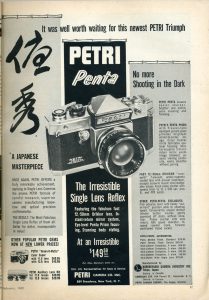
Like many other Japanese camera makers, Kuribayashi would see quite a bit of success in the 1950s. They would release their first 35mm rangefinder in 1954 and their first 35mm SLR in 1959. As was customary at this time, in 1962 Kuribayashi would change it’s name to that of its most successful camera and became known as Petri Camera K.K., or simply, Petri.
Their first SLR, the Petri Penta was a nicely designed and compact camera using the M42 screw mount as used by other manufacturers like Asahi and Praktica. The camera was compact compared to other models by Nippon Kōgaku (Nikon), Chiyoda Kōgaku (Minolta), and Miranda which were taller and heavier. In terms of size, the Petri Penta most closely resembled the Asahi Pentax of the same period. Kuribayashi did not attempt to market the Penta to professional photographers as it’s top shutter speed was only 1/500 sec, it did not have a removable prism, and its standard lens was a f/2 50mm lens.
Instead, it tried to cater to the new “serious amateur” photographer who might be looking for their first SLR. All Petri Penta based cameras had a bright (for the day) Fresnel viewing screen with a large microprism circle for focus assistance. The front shutter release was angled similar to Praktica cameras and was thought to be more comfortable to hold than a top shutter release button.
Some later Penta cameras would raise the maximum shutter speed to 1/1000 sec, but then go back down to 1/500. Perhaps Kuribayashi’s unique cam-based shutter cocking system could not consistently hit 1/1000 sec which might explain why so many of them had the lower speed.
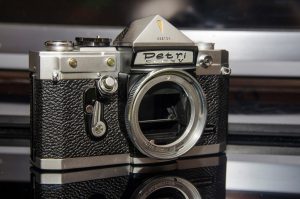
Strangely, a year after the release of the original Petri Penta, a new model would replace it featuring an all new breech lock mount instead of the more common M42 screw mount. This required all new lenses that would be specific to Petri. On the plus side, this did allow for automatic stop down of the aperture when shooting. This allowed a photographer to compose and focus their image with the aperture wide open and only stop down the instant the photo was taken. Other features of the second model were a faster 1/1000 shutter speed and a self timer.
Petri would continue their unique breech lock mount into the early 1970s. In total, there would be 7 different variants of the Petri Penta line, ending with the Penta V6-II in 1970. In 1971, the Petri FT would be released which would add a built in light meter, but sadly it meant the body size and weight would increase in addition to losing the handsome design of the Penta line. In 1974, Petri would release a model called the FTX, which possibly due to poor sales, would abandon it’s breech lock lens mount for the dated M42 screw lens mount. This was a curious move by Petri to go “back” to the M42 mount because by 1974, almost every other maker of screw mount lenses had abandoned the design for more advanced breech and bayonet mount lenses. It would seem that the company used this as a last ditch effort to stay in the SLR market. Petri cameras of the mid 1970s were heavy and unattractive models that struggled to compete with more advanced models by Nikon, Canon, and Minolta. In 1977, Petri would stop making it’s own cameras, and would release a line of ‘GX’ series models using the Petri name, but really made by Cosina.
Petri’s Penta cameras were generally highly regarded and well built. They saw moderate success in export sales throughout the 50s and into the 60s, but like Miranda, who was another Japanese camera maker, they had a difficult time transitioning into the electronic age and mass producing their products. As a result, Petri was heavily outsold by it’s competition from Nikon, Canon, Minolta, and Pentax. The company would limp into the 1970s selling it’s products under a variety of other nameplates before finally going into bankruptcy in 1977. The Petri name would be revived a couple of times in the coming decades making a variety of products such as telescopes, but it would not be the same company.
Today, these earlier Petri SLRs are rarely talked about. Before acquiring this Petri Flex V, I had never even seen one before. Perhaps it was their poor reputation in the 70s, or their use of a proprietary lens mount which was not supported by anyone else, but Petri remains an afterthought in the modern collector’s market. The sad thing is, that for a while, these cameras were really nice models with an attractive and compact design. Had Petri had better success in the 60s and 70s, there’s a chance that the company could still be around making digital cameras like Nikon, Canon, and Pentax do today.
Repairs
I picked up the Petri Flex V from a guy claiming it worked well but when I received it, I noticed that it had a couple of pretty severe problems. The first being that the attached Petri lens was completely inoperable. Neither the focus, nor the aperture ring would budge. Prime lenses like this are generally pretty simple, so I was optimistic that I would be able to open the lens up and resolve whatever was causing it not to work. Sadly, I wasn’t. I won’t go into the specifics, but the lens had internal damage which would have made repair unlikely.
The second issue was that for some reason, all speeds 1/30 and slower would fire and cause the mirror to get stuck in the up position. 1/60 and faster all worked OK. This told me that something in the slow speed governor was hanging up the mirror.
With these two issues, I contacted the seller and asked to return the camera. He refunded my entire purchase price (including shipping) and told me to keep the camera. So now I was stuck with this free, but broken camera, so I did what any vintage collector would do, and that was to put it on a shelf for some undetermined point in the future.
Months passed and I eventually found the time to revisit the camera. Having a little bit of experience with a stuck mirror on a Miranda and Pentax, I knew that the issue most likely was beneath the bottom plate. I removed the 4 screws holding it on and exposed the underside of the camera. Now, as I’ve said a number of times on this site, I am no camera repair technician. I am a guy who likes to tinker with things. I have removed the bottom plate on several SLRs and on occasion been able to resolve an issue. While each manufacturer has their own specific design, the general concept of how SLRs work is generally pretty similar. There is always some combination of round gears, long levers, springs, and other doohickeys that make the camera work. Yet, what I saw inside the Petri was a design I had never seen before.
Instead of a combination of round gears, the innards of the Petri are based around a single long camshaft with a large torsion spring wound around it. It resembles a very small version of the type of spring that assists opening and closing of a garage door. Watch the video above to show normal operation of the Petri’s central camshaft as I fire the shutter several times. When you cock the shutter, this torsion spring spins around the camshaft putting tension on it. When releasing the shutter, the spring flies back to it’s original position, taking the camshaft with it. The entire process is quite interesting to watch and I made a short video of it in action. Something I noticed is that when the slow shutter speeds are selected, something is moving inside of the camera on the side of the camera opposite of the shutter release. This must be where the slow speed governor is located.
I couldn’t see anything obviously bent, broken, or out of position, so I did what anyone with a free camera would do…I doused it in Ronsonol! To my amazement, the camera instantly started working correctly at the slow speeds. I set the shutter speed to 1/2 second and I fired the shutter, and to my unscientific ears, it sounded like half a second. An eighth of a second sounded like an eighth of a second, and so on. I was very pleased with myself. But would it last?
I would repeat the cycle of Ronsonol and then letting it dry for a day and trying again, but each time, when the Ronsonol would dry, it would stick again. Whatever I was “fixing” was only working because the Ronsonol was acting like a lubricant. When it dried, the lubrication was gone, and it would stick again. I couldn’t see any other way to get to the where the slow speed governor was, without completely disassembling the camera, which was something I didn’t want to try. So with no other options (and a free camera) I just kept repeating the Ronsonol/drying cycle. After about a week of this process, the camera started to continue to work after the Ronsonol had dried. After I felt like it was working, I left the camera to sit on a shelf for about a week and I tried it again, and to my delight, it continued to work properly at all speeds, no more stuck mirror!
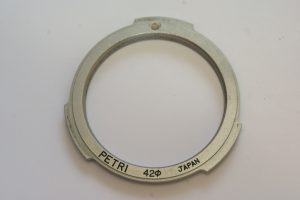
So, now that I resolved one of my two problems, what do I do about that lens? This is an SLR, so I could have just taken the simple path and found another Petri lens online and been done with it. But what fun would that be? I have so many other lenses in my collection, why couldn’t I adapt something that I already had to make it work? In my early research of this camera, I had learned that Petri made a Petri -> M42 adapter which would allow screw mount lenses to be used on the camera. That seemed like a perfect option, and as fate would have it, Robert’s Camera in Indianapolis, IN happened to have one listed for $15 with free shipping. I sent them a “Make an Offer” for $10 and they agreed. So, a Paypal transaction, and a couple of days later, I had my adapter, and armed with a range of Yashica and Takumar M42 lenses, I was ready to go shooting.
Or so I thought. The M42 adapter is a very simple flat metal ring that has the necessary tabs for the breech lock mount and inside of it was a 42mm hole with some screw threads in it for the lens. The problem is in the mount on the camera itself. If you look at the picture earlier in this article, you can see the Petri mount has a lip that extends out beyond the lens mount plane. When I had the adapter in place, if I tried to screw in any of my M42 lenses, this lip would get in the way preventing the lens from being screwed all the way in. This caused the lens to sit too far away from the body of the camera, almost like there was a very small macro extension tube in the way. This meant that I would never achieve infinity focus. I tried every single Takumar and Yashica screw mount lens I had, and they all hit this lip.
For a while, I contemplated just leaving it as it is and seeing what I could do with some closeup shots with this camera, but then I came to my senses. I can do macro shots on any other camera I have. If I wanted to use this camera and write a review of it, I wanted it to work the way it was supposed to. I would either need to forego the adapter and get a real Petri mount lens, or find an M42 lens that was shallower and wouldn’t hit the lip of the mount. At that moment I remembered that I had one more M42 lens.
Enter the KMZ Helios 44-2. I got this lens a while back in a lot of miscellaneous camera stuff. The lens is in fair condition with many cleaning marks on the front element. I had played with it a bit on my Nikon D7000 with a M42 -> Nikon F mount adapter and found that despite the cleaning scratches, the lens still rendered images quite well. The Helios has a pretty good reputation as being a well performing lens with an uncharacteristic out of focus swirly “bokeh” look that is very appealing to some photographers. Not really having had a reason to try out this lens on a film body, I dug it out of my camera closet, screwed it into the Petri camera and to my delight, it fit perfectly inside of the Petri mount without hitting that lip.
So, with my recently cleaned shutter, and “odd couple” lens pairing of an uncommon Japanese SLR with a Soviet era M42 lens which itself is based off the German made Zeiss Biotar lens, I loaded in some film and went shooting.
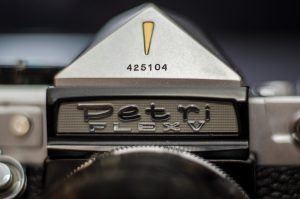
My Thoughts
This is actually my second Petri made SLR. The first was a Carena SRH 1001 which was a brand-engineered Petri FT 1000. It was one of the very last mechanical M42 cameras and as best as I can tell, it was made in 1978. The thing is literally a tank. Its large, heavy, ugly, and just wasn’t anything I had any interest in using. Although in excellent condition, I sold it for maybe $5.
The Petri Flex V is absolutely nothing like the FT 1000. This is a good looking, nicely designed, lightweight SLR, with an ergonomic body. I have other cameras with front shutter releases like my Miranda SLRs and the Exaktas, but the Petri takes a cue from Praktica and puts the front shutter release at an angle. This, in my opinion, is the perfect place for a shutter release. I find that when holding the Petri, my finger is drawn to that position. For as common as the top shutter release is on so many mid to late 20th century cameras, its actually a bit of a stretch for your finger to get there. Modern digital SLRs like my Nikon D7000 actually have the button in a somewhat angled orientation that is more forward than on most classic SLRs. I find it curious how so few camera makers back then chose the front angled position for the shutter release as opposed to the much more common top release. My guess would be that having the shutter out front required a more advanced linkage of some kind. Who knows, but whatever the reason, I am glad they did it because it is very comfortable.
The ergonomic benefits don’t end there. The Petri Flex V is a compact and lightweight SLR and is much lighter than many other 60s and 70s SLRs. I would say that in terms of size and weight, this camera most closely resembles early Pentax SLRs. While I wouldn’t go quite as far as to say this is a pocketable camera, it is quite a bit smaller than many models in my collection and it’s weight makes it much less of a strain around your neck than if you had to carry it around on a full day trip to the zoo.

Of course, this is an entirely mechanical camera, so there is no auto exposure or meter to worry about. You set the shutter speed using the dial on top of the camera and aperture on the lens. Since the only lens I could get to fit with the Petri -> M42 adapter is the Helios 44-2, I can only comment on this one lens, but it’s worth mentioning that my particular Helios is an earlier “preset” model that actually has two separate aperture rings. An outer ring sets a minimum aperture limit, and the inner ring actually changes the aperture. It’s a curious design which I have not encountered on another lens, but basically, you use one ring to set what you want the aperture to be (for example f/8). Then you use the inner ring to open the lens all the way (f/2) for focus and composition. Then once everything is to your liking, you rotate the inner ring as far as it will go, and it will stop at your chosen aperture setting of the outer ring (f/8). This allows you to quickly get to your chosen aperture without having to think about it. It takes some time to master using a preset lens as it is counter intuitive because you basically have to set the aperture ahead of time with one ring, and then manipulate it using a second ring.
While shooting with the Petri, I can say that it is an extremely easy to use camera. I shot with it entirely using Sunny 16. Knowing the Helios’ reputation for “circular or swirly bokeh”, I attempted to recreate this effect as much as possible. Normally, when shooting with a lens, the out of focus details resemble circular orbs. These orbs are generally uniform in size and shape. The swirly bokeh of the Helios has somewhat of a cat’s eye effect on the out of focus details that go in a complete circle. Instead of individual orbs, you get these elongated ovals that make a 360 degree circle around the entire image. Describing the effect with words is rather difficult, but you’ll know it when you see it. I have an example of a photo with swirly bokeh which I found on the Internet.

There are whole articles including this one by Mike Newton that explain how to achieve the swirly bokeh effect. Some have suggested that the swirly bokeh is actually a result of a defect in the lens’s optic design. Whether it is a defect, or an intent, it definitely contributes to it’s near cult-like reputation. As best as I can tell, it happens most often when shooting with the lens wide open at f/2 at objects 8-10 feet away in a wide open and well lit space.
The “preset” feature of the lens which I talked about earlier is something that I could get used to. On paper, it sounds like a great idea, and I guess when this lens was made, it was a good alternative to lenses with automatic diaphragms, but boy, is it awkward to use. In my time using the Helios 44-2 on this Petri camera, I could never get used to how changing the aperture worked. Yeah, it worked, but I really did not like the experience. I found having to move my hand between two separate rings was disruptive, and in some cases, caused me to select the wrong aperture altogether if I wasn’t careful.
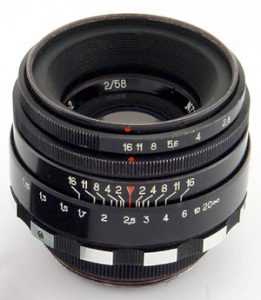
My only other experience with a Helios lens is on the KMZ Start which had a proprietary version of the Helios specific to that camera that did not have the preset feature, so I cannot comment on what this lens might be like using a different variant. In my limited research, later Helios lenses do not have this feature either.
I found the experience shooting with the Petri and Helios combination to be rather unpleasant. This made for a bit of an interesting combination because I really enjoyed the size and ergonomics of the Petri body, but the Helios lens felt like it was getting in the way during most shots. I have used other front shutter release cameras before, but the positioning of the shutter release was perfect for my hands. I really liked the location and the angle of the shutter release as my finger naturally rested there every time I picked up the camera.
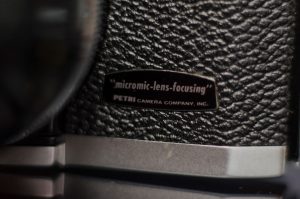
Looking through the viewfinder, I found the Petri to be bright and easy to focus, especially when compared to other early 1960s SLRs. It has a microprism focus aide in the center of the viewfinder, which Petri referred to as “micromic-lens-focusing’. They were so proud of this feature, that they included a metal plate on the front of the body to let you know it was there. Although I generally prefer SLRs with a split image rangefinder, I found that the entire viewfinder was bright enough for most situations.
I really wish I could have experienced the Petri Flex with an original working Petri lens, as I believe my overall impression was altered at least somewhat, by the Helios lens. Sadly, I may never get to do this with this particular example as around 3/4th of the way through my inaugural roll of film, the entire shutter mechanism completely locked up. The shutter wouldn’t fire and I couldn’t advance the film. Had I just started a new roll, I would have tried to open up the camera and extract the film to see if I could fix it. Since I had at least 18 or so shots already taken, I decided to just rewind the film back into the canister and send it in to be developed. My hopes were not high that the frustrating experience with the Helios lens would return me any decent shots, but there was only one way to find out.
My Results
Shooting vintage cameras is a hobby that is probably not for the faint of heart. If you get your hopes up too high for a special model, there is a good chance you’ll get your hopes shattered, but then you’ll have these cameras where you don’t expect anything and you get back results that blow anything you might have hoped for way out of the water. I had a similar experience with the AGFA Billy-Clack which is a simple fixed focus 1930s folding camera with a 2-element lens, a single speed shutter, and limited aperture sizes. I bought that camera for less than $5 and didn’t expect much out of it, but ended up with some great shots.
Normally, when posting an initial review of a camera, I try to limit myself to 8 of the best shots, but above are 12 of the 18 that I shot on that first roll. Keep in mind that the camera completely jammed around the 18th frame, so I never managed to make it through the whole roll. Simply, every shot was great. There are some issues, sure, but considering what I needed to do to this camera to get anything out of it at all, I am simply stunned.
For starters, you can see some curtain capping in a couple of shots. I find this interesting because I mostly used the same shutter speeds throughout the entire roll. Capping like this usually happens only on the fastest speeds. I do not understand why it happened on some shots and not others. This could hint that one or more of the springs inside of the camera is losing tension on one of the curtains. Its possible that whatever caused this capping also caused the camera to stop working altogether, there simply isn’t any way to know.
But looking at these shots, wow. The Helios 44-2 lens delivered a home run. It’s also worth noting that this particular lens isn’t in perfect condition. The front and rear elements have light surface scratches on it. Normally, light scratches don’t have any impact in the image, which remains true here, but to think that these were shot with a less than perfect lens on a camera body with very serious issues just amazes me.
After extracting the film from the jammed Petri, I really thought I would never use it again. Even if I would have gotten average shots, I have so many more capable and more reliable cameras in my collection, I never thought it would come back to it, but after seeing these shots, I really think I need to. Maybe my particular example isn’t salvageable, so maybe I need to find another. Perhaps I’ll get a chance to try one with the original Petri lens. Maybe that lens wont be as good as this Helios, but there is a very good chance it’s at least decent. I do not know that any Japanese optics company in the early 60s made a bad 50mm prime.
My Final WordHow these ratings work |
The Petri Flex V is a very nicely designed early 1960s all mechanical Japanese SLR that is lightweight and has some of the best ergonomics of any camera from the era. In terms of size and weight, it compares favorably to the early Asahi Pentax SLRs. It has a bright and easy to use viewfinder, and although it was designed for a proprietary Petri lens mount, I was able to locate a Petri -> M42 lens adapter. The biggest cons are that without the adapter, you are limited to a single lens mount that was not shared by any other manufacturer, and Petri cameras have questionable reliability. I’ve read many reviews stating that few survive 50+ years and of the ones that do, they will almost always have some issues. If you can find one in working order, this is a really great SLR. It fits well into your hand, the shutter release is in a perfect location, and it makes great photographs. | ||||||
| Images | Handling | Features | Viewfinder | Feel & Beauty | History | Age | |
| 2 | 2 | 1 | 1 | 1 | 0 | 20% | |
| Bonus | none | ||||||
| Final Score | 8.4 | ||||||
Additional Resources
http://camera-wiki.org/wiki/Petri_Penta
http://advwks.blogspot.com/2009/11/petri-cameras-bet-you-can-collect-just.html
http://www.pentax-slr.com/181841703
https://simonhawketts.com/2016/05/23/stripping-down-and-cleaning-a-petri-flex-v/
http://www.collection-appareils.fr/x/html/camera-2053-Petri_Petri%20Flex%20V.html

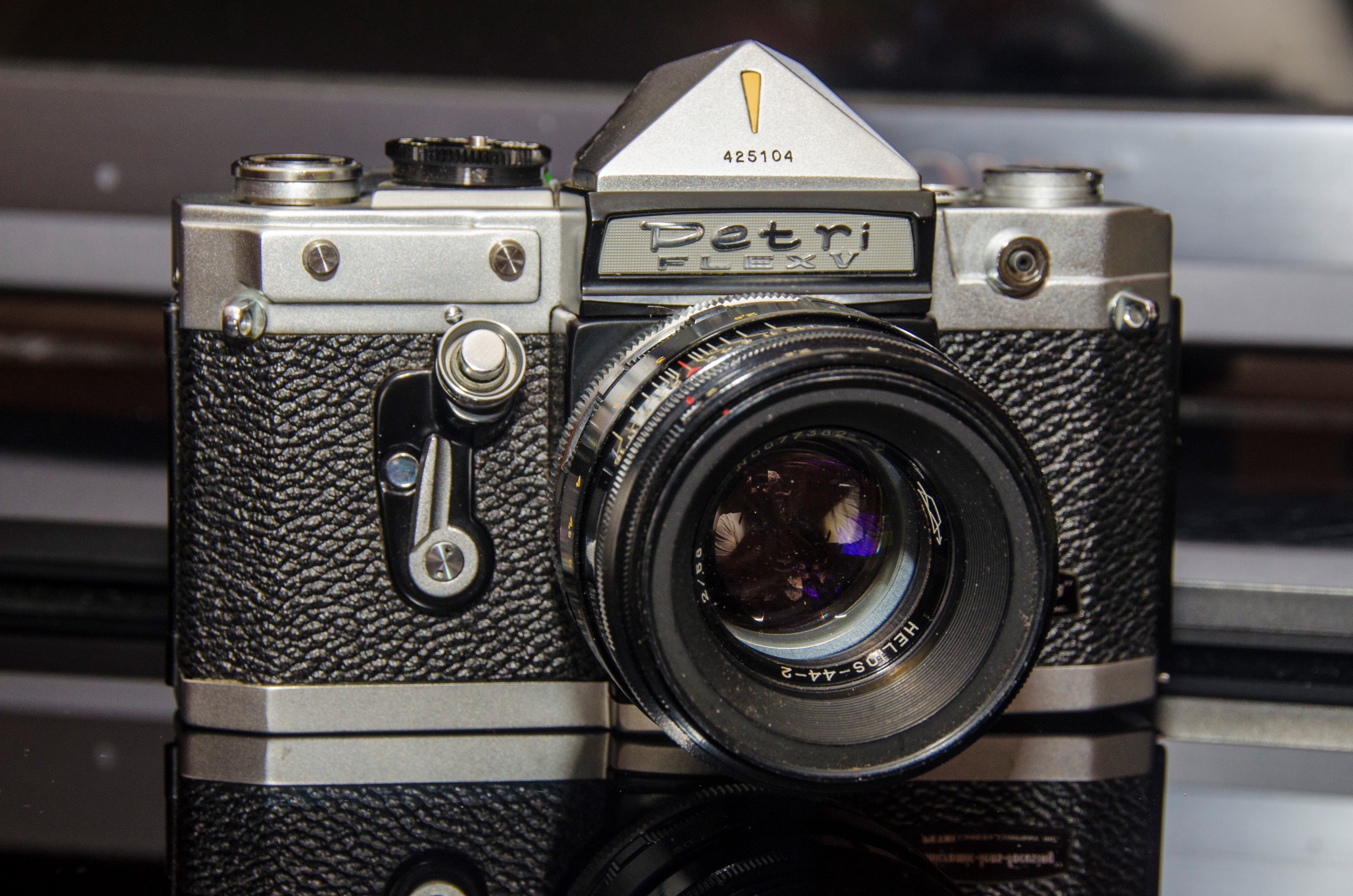
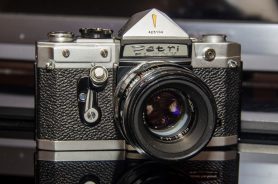













I just bought a Petri Flex V serial number 315495 with a Kuribayashi 55mm f2. Soon as I get it I’ll post up and let you know the lens mount. Looks to be in excellent shape.
When I was in H S 1958-1962 I studied photography and shot pictures for the school newspaper and yearbook. My best shot was not sports but a shop shot of Boys’ Tech H S Aero Shop, which was my major (Aeronautics). I wrote the accompanying article but the photo was awesome; we had an actual F-84 Thunderjet and its engine, along with a P-51 Merlin engine and many other aircraft engines, thanks to Mr. Genski our shop teacher. Anyway the front page photo showed my fellow Aeronautics students working on a wing and in the cockpit. I mainly used a 4X5 Graphic Crown and processed/enlarged black and white photos. I remember seeing the full-page ads for the Petri Penta and seeing them priced at the back of Popular Photography and wishing I could buy one but no luck. But my dad bought a Yashica Mat 21/4 square for me, which I used for years. Eventually I got a Minolta SRT 101 with a f-l.2 lens. Photography has always been a big part of my life: freezing History. After H S I ended up serving in the Navy aboard a nuclear ballistic missile sub and later some W WII diesel boats. One of our boats was sunk in WWII by its own poorly made torpedo. The Japanese had excellent torpedoes, as in Pearl Harbor.
So now I am 77 years old and finally got a Petri Penta V and about 25 used models from all over the world. The wonders of the internet and e-Bay. The Petri Penta/Flex from Japan are almost mint condition and tend to work quite well. When I retire soon I plan on taking the non-functioning models apart and fiddle around with them. I also bought a bunch of used Petri lenses of all focal lengths that I could find. I have shot a number of rolls and the results were really good.
My main point is this: after seeing this video of the workings of the shutter mechanism and fine design and workmanship of these Petri SLRs I now understand why the Japanese torpedoes worked so well.
Thanks for sharing! There aren’t many articles on Petri cameras, and it’s nice to see them get the respect and appreciation that they deserve.
Petri actually didn’t ‘abandon’ their breech lock mount, as it was offered on their last production camera, the FA-1. It’s actually a very sensible mount, similar to the Pentacon Six mount. Petri reintroduced the M42 mount with the FTX model (alongside their breech-lock SLRs) in order to gain share in the popular screw-mount camera and lens market, according to author John Baird in his book, Kuribayashi-Petri Cameras. It’s a book that’s well worth reading, if you can find a copy.
My father gave me a Petri Flex V that he bought second hand in a camera shop in Guildford (Surrey) UK, when I was just 14 years of age. I’m now nearly 66, and still have it. I learnt photography with this camera! Although I haven’t run a film through it in many years, it appears to be in perfect working order. The shutter releases fine and appears to be according to the speed selected. The lens focusing is a bit stiff, but you get there. The manual/auto diaphragm selector works fine. And even the self-timer works! I later switched to Pentax SLR and still use them. I also now have the Pentax K-70 digital.
I remember selling this camera at Dixons in 1965.It was very well made with a super focusing screen for its day.It stacked up very well against the Pentax S1A the then current cheaper Pentax.I still remember selling one to a gent who made about a dozen visits before final purchase.I wanted one myself but at 16 years age it was WAY above my reach.Thanks for the enjoyable article.